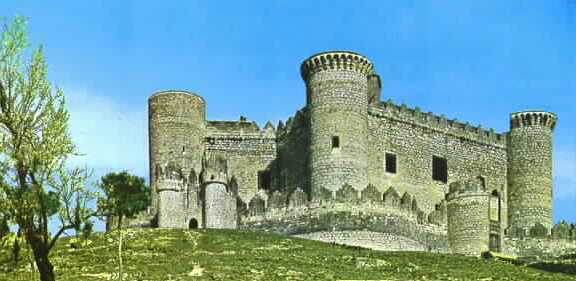

Mother country of Fray Luis of Leon, this municipality is in the south east of the province of Cuenca (about 100 kms. from the capital) and is accessible by travelling on Nacional 420. Villa de Belmonte was donated by Fernando III to his son the Infant Don Manuel. Inheriting it later his son Don Juan Manuel constructed his residential palace there in 1323; today it is in ruins. In 1371 Pedro I incorporated the villa to Real Corona freeing it from Alarcón, but in 1398, Enrique III, donated the villa to Don Juan Fernandez Pacheco, native of Santarén (Portugal), first Lord of Belmonte.
According to the dated document of October 12, 1456, Don Juan Pacheco, first Marquess of the Marquesado of Villena, ordered a fortress or castle to be constructed at the top of the hill of San Cristóbal and a wall that surrounded the villa until the castle, whose third part would be paid for by the Marquess and the rest by its vasallos, the neighbours of Belmonte.
In 1467 the villa of Belmonte was in the hands of the heir of marquesado of Villena Don Diego Lopez Pacheco, son of Don Juan Pacheco and second Marquess of Villena. Like his father, he also sided with La Beltraneja whom they tried to legitimize as the queen of Castile. They opposed the Kings "Católicos" who, after the 1476 battle of Toro, snatched all his possessions and forced him to swear fidelity to them. They once again incorporated the villa of Belmonte to the Corona declaring it independent villa.
At the beginning of XIX century, during the French invasion, Belmonte castle was used by the French as a jail.
In XIX century, Eugenia de Montijo, after dying her husband Napoleón III, took refuge in the castle of her ancestors, where big reforms were made.
 Collegiate Church of San Bartholomew.
Collegiate Church of San Bartholomew.  Convent of the Jesuitas.
Convent of the Jesuitas. 
 Walls.
Walls.  Plaza de Enrique Fernandez.
Plaza de Enrique Fernandez.  Hermitage of Our Lady of Grace.
Hermitage of Our Lady of Grace.  Agrarian Cámara.
Agrarian Cámara. Convent of the Trinitarios.
Convent of the Trinitarios.
Those that next is mentioned, are many of the illustrious
children of this noble town. Many appear in several publications with
small biographies; others have been found in the parochial file and
it sees that to his passage by this life they left some drip of light.
They are a good handful of illustrious children of Belmonte who are
honest to their town with feats, written and exemplary lives.
Fray Luis de Leon.
San Juan del Castillo.
Fray Benito de Alarcón, Don Diego de Alarcón,
Francisco de Alarcón y Peñafiel, Sor Ana de Aliende, Fray
Benito Almansa, Fray Francisco Almendros, Alonso de San Pedro, Alonso de
Arboleda, Sor María de la Cruz, Gabriel Barahona, Fray Pedro Ballesteros, Pedro de Bedoya Osorio, Manuel Alfonso Bedoya Osorio, Mateo Belmonte, Joaquín y Federico Belmonte, Andrés de Cabrera, José Calot, Juana, Jerónima-María y Jacinta
Castillo, Juan Cisneros, Fray Cristóbal de San José; Juan
Cubillo; Francisco Dávila; Fray Luis Dávila; Juan Dávila;
Alfonso Dávila; Sebastián Donoso; Francisco de Espinosa;
Sor Juana Evangelista; Juan García Parrado; Juan Fernández
Pacheco; Pero-Albar Fernández de León; Pedro Girón;
Agustín Guerrero; Jerónimo Guedeja; José Cipriano
Hernández; Pedro de Igueras; Ruperto Jurado Prieto; Diego de Hinestrosa
e Iniesta; Sor Jerónima de Jesús; Lope de León; Gómez
de León; Juan de León; Luis de León; Francisco de
León; Francisca de León; Diego Roque López Pacheco;
Fray Pedro de Lorca; Licenciado Lucas; Miguel Lucas Iranzo; Tomás
Lucas; Antonio Lucas Iranzo; Alonso Lucas Iranzo; Isabel Lucas Iranzo;
Domingo Martínez; Tomás Martínez-Palomino y Bedoya;
Alonso Fernández Melgarejo; Tomás Melgarejo Ramírez
y Ponce de León; Antonio Monreal; María Monreal; Fray Luis
de Montoya; Excmo. y Rvmo. Sr. D. Luis Morales; Diego de la Mota; Venerable
Fray Andrés de Moya; Don Diego Muñoz; Venerables María
Luisa y Luisa Muñoz; Gregorio Osorio; Isabel Osorio; D. Pedro Osorio
de Guadalaxara; Miguel Ortuño Villena; María Pacheco; Juan
Pacheco; Antonio Palomo; Gregorio Quintana; Jorge Quintana; Martín
de Quirós; "La Revegida"; Alonso Severo; Alfonso Serrano;
Juan de Soria; Fernando de Salas; Jacinta Varcálcel; Juan de Varela;
Inés de Varela; María Varela Osorio; Gabriel Vázquez;
Francisco Vázquez; Pedro Vázquez; Fray Juan de Jesús.
Its situation, between Cuenca and Albacete, causes that it is under the influence of both. The most typical plates are:
The Cultural Association "Infant Don Juan Manuel" was born in Belmonte from the restlessness that causes the deterioration that undergoes the Patrimony Histórico-Artístico and Medioambiental in order to promote it, to safeguard it and to disclose it, and in order that its knowledge contributes to a greater sensitivity and promotion of the historical wealth that locks up this small corner of Mancha Conquense.
MY GRATITUDE TO
Have a look at my guestbook
![]() If you want to write a message, click here
If you want to write a message, click here![]()